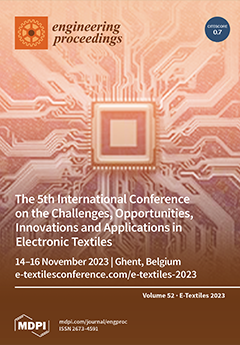Eng. Proc., 2023, E-Textiles 2023
The 5th International Conference on the Challenges, Opportunities, Innovations and Applications in Electronic Textiles
Ghent, Belgium | 14–16 November 2023
Volume Editors:
Russel Torah, University of Southampton, UK;
Kai Yang, University of Southampton, UK;
Beckie Isaia, University of Southampton, UK;
Paula Veske-Lepp, University of Ghent, Belgium;
Frederick Bossuyt, University of Ghent, Belgium;
Stephen Beeby, University of Southampton, UK.
- Issues are regarded as officially published after their release is announced to the table of contents alert mailing list.
- You may sign up for e-mail alerts to receive table of contents of newly released issues.
- PDF is the official format for papers published in both, html and pdf forms. To view the papers in pdf format, click on the "PDF Full-text" link, and use the free Adobe Reader to open them.




